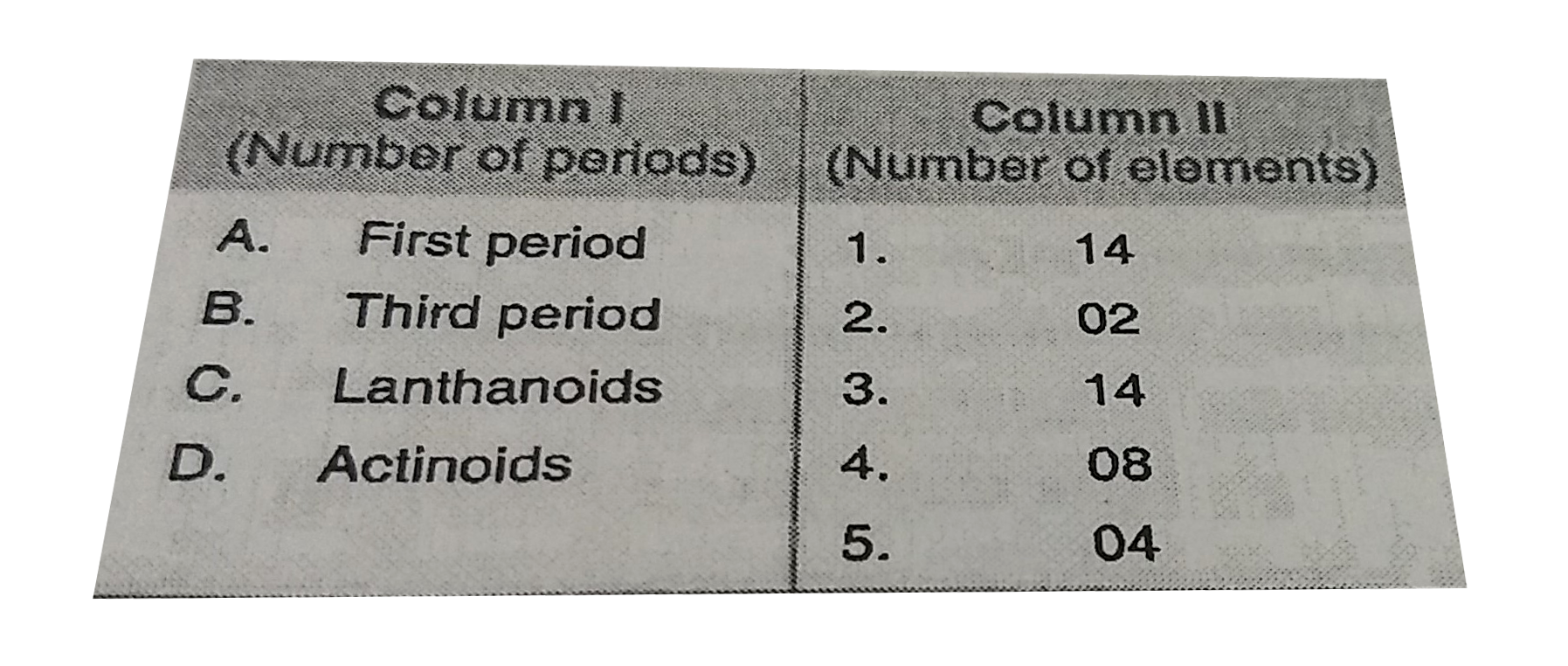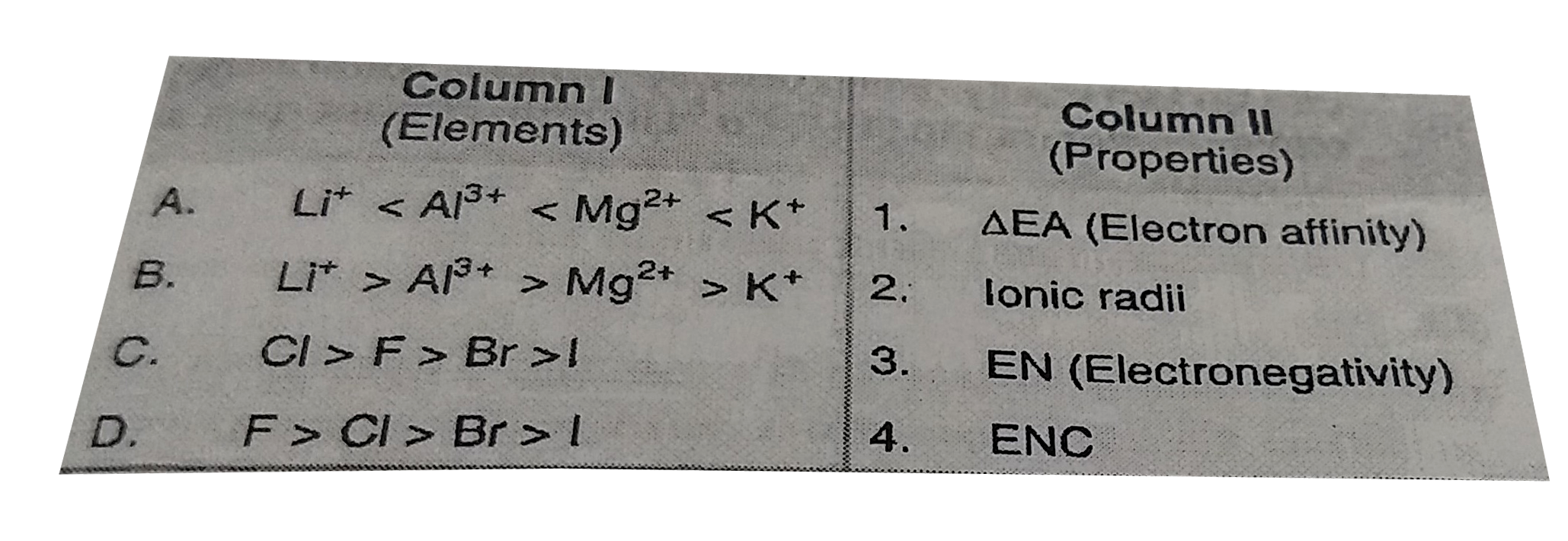Complete Solutions to Practice Exercise of chapter PERIODIC PROPERTIES of Class 11 book with complete answers and questions
| Class 11 | CHEMISTRY |
| Chapter | PERIODIC PROPERTIES |
| BITSAT GUIDE | Practice Exercise |
| Number Of Questions | 59 |
| Academic Year | 2023-24 |
Which of the following has firstly organise the elements according to same trend ?
View SolutionJohann Dobereiner gave the idea of trends among the physical and A… of several groups of three elements. Here, a referes to
View SolutionLother Meyer plotted the physical properties such as atomic volume, melting point and A…. Against atomic weight. Here, A refers to
View SolutionLother Meyer drew a graph showing the relation between
View SolutionWhich of the following is incorrect explanation about Mendeleef's periodic law ?
View SolutionWhich basic concept was used by Mendeleef for organishing the elements ?
View SolutionWhich element was named as eka-silicon in Mendeleef classification of elements ?
View SolutionThe statement that is not correct for the periodic classification of elements is `:` a)The properties of elements are the periodic functions of their atomic numbers. b)non-metallic elements are lesser in number than metallic elements. c)the first ionisation energies of elements along a period do not vary in a regular manner with increase in atomic number. d)for transition elements the `d-` subshells are filled with electrons monotonically with increase in atomic number.
View SolutionThe period number in the long form of the periodic table is equal to
View SolutionWhich of the following is incorrect ?
View SolutionMatch the Column I with Column II and select the correct answer by given codes.

Codes
View SolutionObserve the following statements,
I. The physical and chemical properties of elements are the periodic functions of their electronic configuration.
II. Electronegativity of fluorine is less than the electronegativity of chlorine.
III. Electropositive nature decreases from top to bottom in a group.
The correct answer is
View SolutionThere are 10 neutrons in the nucleus of the element `_(Z)M^(19)` . It belong to
View SolutionThe third alkaline earth metal ion contains number of electrons and protons as
View SolutionA metal having electronic configuration
`1s^(2), 2s^(2)2p^(6), 3s^(2)3p^(6)3d^(10), 4s^(2)` is in
View SolutionWhich of the following orbitals are in the process of filling in the 6th period ?
View SolutionThe configuration to second excited state of the element is (O) electronic with `O_(2)` or `P^(-)` or `Cl^(+)` is
View SolutionThe element having atomic number 33 lies in the group
View SolutionGeneral configuration of outermost and penultimate shell is `(n - 1) s^(2) (n - 1) p^(6) (n - 1)d^(x) ns^(2)`. If `n = 4` and `x = 5` then no. of protons in the nucleus will be
View SolutionGenerally, the valency of noble gases is
View SolutionThe least stable ion among the following is
View SolutionThe electronic configuration of an element is `1s^(2),2s^(2),2p^(6),3s^(2)3p^(3)`. The atomic number and the group number of the element X which is just below the above element in the periodic table respectively, are
View SolutionWhat will be the IUPAC name of element having Z = 106 ?
View SolutionThe one with the largest ionic size is
View SolutionFluorine and neon have atomic radii in angstrom given by
View SolutionWhich of the following alkali metals has smallest size ?
View SolutionChloride ion and potassium ion are isoelectronic. Then
View SolutionWhich one of the following is correct increasing order of size ?
View SolutionIonic radii vary in
View SolutionThe first ionisation energy of beryllium is more than that of boron because
View SolutionAmong the following, the element with highest ionisation potential is
View SolutionThe isoelectronic ion having lowest ionisation energy is
View SolutionThe value in electron-volt per atom which represent the first ionisation energy of oxygen and nitrogen atom respectively are
View SolutionThe pair in which the ionisation energy of first species is less than that of second is
View SolutionHow many `Cs` atoms can be converted to `Cs^+` ions by ` 1` joule energy , If `IE_1` for `Cs` si `376kJ mol^(-1)` ?
View SolutionHow many joules of energy must be absorbed to convert Li to `Li^(+)` , all the atoms present in `1.00` mg of gaseous Li ? `lE_(1)` of Li is `520.3 kJ mol^(-1)(Li=7)` .
View SolutionThe incorrect statements among the following is
View SolutionIonisation enthalpy of Na would be same as
View SolutionWhich one of the following statements is incorrect in relation to ionisation enthalpy?
View SolutionThe formation of the oixde ion, `O^(2+)(g)` from oxygen atom requires first an exothermic and then an endothermic step as shown below:
`O(g)+e^(-) rarr O^(-)(g), Delta H^(O)=-141kJ mol^(-)`
`O(g)+e^(-) rarr O^(-)(g), H^(O)=+kJ mol^(-)`
Thus the process of formation of `O^(2-)` in gas phase is neon. It is due to the fact that
View SolutionWhich one of the following arrangements represents the correct order of electron gain enthalpy of the given atomic species?
View SolutionElectronic configurations of four elements A, B, C and D are given below
View SolutionIn which of the following options the order arrangement does not agree with the variation of property indicated against it?
View SolutionThe electron affinity values (in `kJ mol^(-1))` of three halogens, `x,y`, and `z`are, respectively, `-349, -333`, and `-325`. Then `x, y`, and `x`, are respectively,
View SolutionWhich one of the following statements is false ?
View SolutionWhich of the following element has highest electronegativity ?
View SolutionIn `C,N,O` and `F` the electronegativity
View SolutionElectronegativity of `F` on Pauling scale si `4.0` Calculate its value on Mulliken scale .
View SolutionTwo elements whose electronegativities are `1.2` and `3.0` the bond formed between them would be
View SolutionCalculate electronegativity of carbon at Pauling scale Given that :
` E_(H-H) =104 .2 kcal "mol"^(-1) E_(C-C) =83.1 kcal "mol"^(-1)` ,
`E_(C-H) =98.8 kcal "mol"^(-1)`.
Electronegativity of hydrogen `=2.1`.
View SolutionWhich one of the following is incorrect ?
View SolutionPauling's equation for determining the electronegativity of an element, is (`X_(A), X_(B)` are electronegativity value of elements A and B respectively, `Delta` represents the polarity of A-B bond.)
View SolutionMatch the Column I with Column II and select the correct answer by given codes.

Codes
View SolutionWhich set contains pair of elements that do not belong to same group but show chemical resemblenes ?
View SolutionWhich pair of elements has same chemical properties ?
View SolutionThe element of second period which forms most acidic oxidie is
View SolutionIn periodic table, melting point/boiling point increases down the group in which of the following group ?
View SolutionConsidering the elements `B, C, N, F` and `Si`, the correct order of their non-metallic character is ?
View SolutionConsidering the elements `B, Al, Mg` and `K`, the correct order of their metallic character is
View Solution
Practice Exercise questions and complete solutions for chapter PERIODIC PROPERTIES of ARIHANT CHEMISTRY (HINGLISH) of Class 11